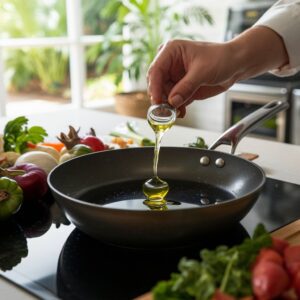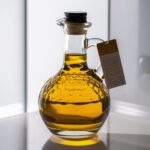Introduction
Cooking oils are essential to cooking techniques all around the world since they can be used as baking, sautéing, frying, and dressing mediums. Because of their adaptability and delicate flavor profile, neutral oils are unique among the many varieties of oils that are accessible.
This thorough book explores the world of neutral oils, including varieties, applications, potential health risks, and storage and selection advice.
What is a Neutral Oil?
A Neutral Oil For Cooking well with a variety of cooking techniques because of its high smoke point and mild, inconspicuous flavor. Neutral oils do not overshadow the flavor of the dish, in contrast to oils with strong flavors like olive or coconut oil.
They are therefore perfect for recipes that require the main flavors of the ingredients to take center stage.
Types of Neutral Oils
Several kind of neutral oils are frequently used in cooking:
Canola Oil
Source:
extracted from the canola plant’s seeds.
Smoke Point:
Around 400°F, or 204°C.
Uses:
Sautéing, baking, frying, and salad dressings.
Nutritional Profile:
It has a high content of monounsaturated fats, little saturated fat, and omega-3 fatty acids.
Vegetable Oil
Source:
usually a mixture of oils from many plants, including sunflower, corn, and soybeans.
Smoke Point:
roughly 400°F, or 204°C.
Uses:
Cooking in general, baking, and frying.
Nutritional Profile:
varies based on the mixture, but is often rich in fats that are polyunsaturated.
Grapeseed Oil
Source:
separated from the grape seeds.
Smoke Point:
Around 420°F, or 216°C.
Uses:
Use for salad dressing, baking, sautéing, and frying.
Nutritional Profile:
Rich in vitamin E and polyunsaturated fats.
Peanut Oil
Source:
taken out of peanuts.
Smoke Point:
about 232°C, or 450°F.
Uses:
Frying is particularly useful for Asian cuisine, sautéing, and deep-frying.
Nutritional Profile:
Rich in vitamin E and monounsaturated fats.
Sunflower Oil
Source:
taken out of sunflower seeds.
Smoke Point:
At about 440°F (227°C).
Uses:
Salad dressings, baking, and frying.
Nutritional Profile:
Low in saturated fats and high in vitamin E.
Safflower Oil
Source:
taken from the safflower plant’s seeds.
Smoke Point:
about 232°C, or 450°F.
Uses:
Salad dressings, frying, and cooking at high heat.
Nutritional Profile:
Rich in vitamin E and monounsaturated fats.
Health Implications of Neutral Oils

The health effects of cooking oils should be taken into account when selecting one. The amount of saturated, monounsaturated, and polyunsaturated fats in these oils can have a big effect on heart health.
Saturated Fats:
Elevated levels of LDL cholesterol have been associated with high consumption of saturated fats, perhaps contributing to heart disease. The amount of saturated fats in neutral oils such as canola, grapeseed, and safflower oil is comparatively low.
Monounsaturated Fats:
These fats are thought to be heart-healthy because they lower levels of harmful cholesterol. Monounsaturated fats are abundant in oils such as peanut and canola oil.
Polyunsaturated Fats:
Omega-3 and omega-6 fatty acids, which are necessary for bodily activities, are among these fats. A balance is necessary, though, as consuming too much omega-6 might cause inflammation. Polyunsaturated fat content is high in vegetable and grapeseed oils.
Culinary Uses of Neutral Oils
Because of their versatility, neutral oils are a must-have in the kitchen. Here are a few typical uses in cooking:
Frying:
For frying, neutral oils with high smoke points work well. Deep-frying is a great use for peanut and sunflower oils since they can tolerate high temperatures without going bad.
Baking:
Neutral oils have a mild flavor that makes sure baked items don’t taste ruined. Cakes, muffins, and cookies frequently use canola or vegetable oil.
Sautéing and Stir-Frying:
The subtle flavor of neutral oils, such as grapeseed and safflower oil, enhances but doesn’t overwhelm the flavors of seafood, meats, and vegetables.
Salad Dressings:
Although neutral oils work well in milder vinaigrettes that let the tastes of the herbs and other components shine through, extra virgin olive oil is still a popular choice for dressings.
Marinades:
As the foundation for marinades, neutral oils aid in the uniform distribution of flavors and the tenderization of meat.
Choosing the Right Neutral Oil
Think about the following when choosing a neutral cooking oil:
Smoke Point:
Select an oil that is suitable for the cooking method you use. Sautéing and frying are best done at higher smoke points.
Flavor Profile:
It is possible for neutral oils to differ somewhat in flavor. Select one that goes well with the meal you are cooking.
Nutritional Content:
Think about the kinds of fats in the oil and how they affect your health. Choose oils that are higher in polyunsaturated and monounsaturated fats.
Price and Availability:
Certain neutral oils are more costly or more difficult to locate. Select one that is both affordable and easily accessible.
Storage Tips for Neutral Oils
Cooking oils must be stored properly to preserve their quality and keep them from going rancid. Here are some pointers for storing:
Cool, Dark Place:
Keep oils out of direct sunlight and heat sources by keeping them in a cool, dark place. Oxidation and spoiling can occur more quickly when exposed to heat and light.
Tightly Sealed Containers:
Oil bottles should be kept tightly closed to avoid air exposure, which can also lead to oxidation.
Refrigeration:
Refrigeration can help some oils, including safflower and grapeseed, last longer on the shelf, but it may also make them hazy. The oil becomes clear again once it reaches room temperature.
Shelf Life:
Take note of how long oils last on the shelf. Over time, oils can go rancid even when stored properly. Verify freshness by checking the expiration date and doing a sniff test.
Environmental and Ethical Considerations
Cooking oil production has an impact on the environment and on morality. Here are some things to think about:
Sustainable Sourcing:
Search for responsibly sourced oils. This may lessen the negative effects of oil production on the environment.
Organic Options:
Because organic oils are produced without the use of artificial fertilizers and pesticides, both the environment and human health may benefit.
Fair Trade:
Certain oils have been linked to deforestation and unfair labor practices, such as palm oil. Choosing oils that are produced responsibly and with fair trade standards will help promote improved labor standards and environmental preservation.
Conclusion
The culinary industry relies heavily on neutral oils because of their delicate flavor and adaptability. You can make more informed decisions in the kitchen if you are aware of the kinds, applications, and health risks associated with these oils. Making healthy and delicious dishes is ensured by choosing the appropriate neutral oil while baking, frying, or dressing a salad.
Through careful consideration of elements such as smoke point, nutritional value, and storage, you may maximize the use of neutral oils in your cooking.
From safflower to canola, every kind of neutral oil has its own advantages and applications. Accept the flexibility of these oils to improve your cooking endeavors while keeping a nutritious and well-balanced diet.
Always keep the ethical and environmental implications of oil production in mind, and make decisions that promote sustainability and fair trade standards. Neutral oils can be a useful and adaptable asset in your cooking if you choose them wisely.



























































